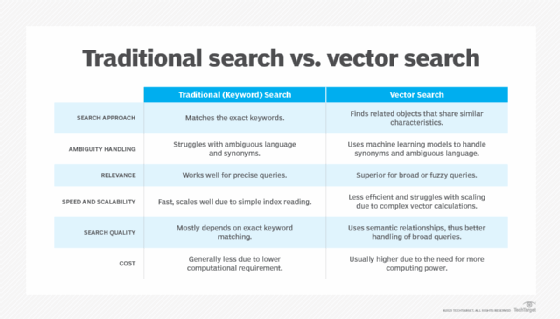Oracle on Thursday launched the latest version of its database service, including new vector search capabilities that are part of the tech giant’s effort to augment data with generative AI where it resides, rather than force users to export data to AI platforms.
In addition to AI Vector Search, Oracle Database 23ai includes smart storage capabilities designed to speed vector searches and new data unification tools, among other features.
Beyond the individual features, the effort to provide capabilities that enable users to join data and AI without moving data is important, according to Sanjeev Mohan, founder and principal at SanjMo.
Isolated data has long been a major concern for organizations because it can lead to poor data quality, including data duplication, inconsistent data sets and incomplete data. As a result, organizations have developed data management strategies to avoid such isolation.
Now, AI presents a new way that data can wind up disconnected in silos, Mohan noted.
If data is exported to different AI clusters, it can wind up separated in those clusters. Therefore, it is significant that Oracle is making a concerted effort to bring AI to the data.
Data changes constantly, so we would rather have AI be part of the same stack as data. That way, AI becomes a compute engine.Sanjeev MohanFounder and principal, SanjMo
“In the past, we have suffered with silos of data,” Mohan said. “Now, if we move data into AI clusters, we will wind up with copies of data, and very soon we will no longer know what is the single source of truth. Data changes constantly, so we would rather have AI be part of the same stack as data. That way, AI becomes a compute engine.”
Based in Austin, Texas, Oracle is a tech giant that among its database offerings provides Oracle Database and Autonomous Database. Autonomous Database is a managed service that eliminates an organization’s responsibility for administering its databases. Oracle Database, meanwhile, is available as a managed service or under enterprise control.
The tech giant’s top database competitors include other tech giants such as AWS, Google Cloud and Microsoft, as well as database specialists such as MongoDB and MariaDB.
New capabilities
Vector search and storage are not new capabilities, dating back to the early 2000s. However, until recently, they were niche applications for search-driven companies that needed to discover relationships between data.
Now, as traditional AI and generative AI explode in popularity, vector search and storage are similarly becoming more widespread.
Vectors are numerical representations of data that give structure to unstructured data such as text, images and audio files to make such data discoverable. In addition, vectors enable similarity searches, which help discover data that has similar characteristics but is not an exact match.
AI models, meanwhile, need to be trained on large amounts of quality data to be accurate. By enabling organizations to operationalize unstructured data — which is estimated to make up more than three-quarters of all data — and find data that is relevant to a particular business application, vector search and storage help provide the requisite data for AI models.
As a result, numerous data management vendors have over the past year introduced vector search and storage capabilities to help organizations train AI models with proprietary data so that models can understand an individual organization’s operations. For example, Neo4j launched vector search capabilities in August 2023, SingleStore did so in January 2024, and AWS has added vector search to some extent to its entire line of databases.
Oracle unveiled plans to add vector search capabilities in September 2023. Oracle Database 23ai now delivers them with AI Vector Search.
The feature aims to enable customers to search unstructured data so that it can be combined with structured data within a database and used to feed and train generative AI models. In addition, it lets developers add semantic search capabilities to new and existing applications so that data is consistent and can be easily discovered to inform models.

Given that vector search is now such a crucial component of AI development, it was imperative that Oracle add such capabilities, according to Holger Mueller, an analyst at Constellation Research.
“AI vector support is critical for all database vendors to keep their customers,” he said.
When combined with other features in Oracle Database 23ai, AI Vector Search should allay any fears customers might have had about Oracle’s support for AI, Mueller continued.
“[The update] is significant as it makes customers confident to stay on Oracle Database and not miss out on AI,” he said. “As such, [the update] is strategic for both customers and Oracle, and for the Oracle ecosystem.”
In addition to AI Vector Search, Oracle Database 23ai includes the following:
- Oracle Exadata to provide storage capabilities designed to accelerate vector searches in the cloud for both large data volumes as well as high user volume.
- Oracle Cloud Infrastructure (OCI) GoldenGate 23ai, a real-time data replication tool to power retrieval-augmented generation (RAG) for generative AI applications.
- JSON Relational Duality, a feature that enables developers to use JSON in addition to SQL to both retrieve and store relational data using REST or JSON APIs.
- Operational Property Graph to help developers create applications with graph queries to discover and analyze relationships between data such as relational data, JSON data and spatial data.
- Oracle Globally Distributed Database with RAFT replication to enable data storage in the cloud across multiple physical databases in multiple locations.
- Oracle True Cache, a feature aimed at improving application response times while simultaneously reducing compute power demands on database servers.
- An in-database SQL firewall to protect against unauthorized SQL operations such as SQL injection attacks.
While AI Vector Search is the critical new capability, the strength of Oracle Database 23ai lies in its interconnectedness, according to Mueller.
Features such as OCI GoldenGate 23ai and the JSON and graph capabilities are significant, he noted. But beyond the importance of individual features is their combination.
“The GoldenGate support is critical, and so are the converged features, [but] it is a lot of suite-level synergies that Oracle is bringing to the table,” Mueller said.
Mohan similarly said the key advance of the Oracle Database update is its unification of capabilities.
Oracle has historically supported structured data. The update adds support for unstructured data, graph capabilities and even spatial data, he noted.
“Users need full context of their data,” Mohan said. “That context is not sitting just in an ERP structured database, but in PDF documents, call center records, in spatial data. Oracle is unifying disparate AI workloads into a single system.”
For example, using capabilities such as vector search and JSON Relational Duality together represents unification, he continued. In addition, features such as Exadata that adds hardware capabilities, GoldenGate that adds ingestion capabilities and Operational Property Graph that aids developers address different needs in one environment.
“I like the totality,” Mohan said.
Next steps
With the release of Oracle Database 23ai, Oracle’s database capabilities are competitive with those of its peers, with its offering more complete than some and essentially in line with others, according to Mueller.
“Oracle leads over transactional database competitors for now and is as attractive as alternative offerings like MongoDB,” he said.
Mohan likewise noted that Oracle’s capabilities match up well against those of other database vendors. Its databases are multimodal, which gives it an advantage over some vendors. Google, however, is another vendor offering the same capabilities.
Google, meanwhile, owns its own large language models, while Oracle employs partnerships with LLM providers, giving Google a subtle edge as far as enabling AI development.
Given that database vendors all are adding capabilities that enable users to build AI models and applications, it would be prudent for Oracle to provide customers not only with tools such as vector search, but also an environment for AI development, Mohan continued.
Most database vendors now provide RAG capabilities, including vector search. RAG, however, is not always enough to train a model. Sometimes more fine-tuning needs to be done.
In addition, governance of AI and the data that fuels it is an area in which Oracle has room to improve its database platform, according to Mohan.
“I have not seen a lot on data and AI governance, which go hand in hand,” he said. “Oracle needs to now look at how to speed up its developer ecosystem so customers can build AI agents quickly and deploy them.”
Eric Avidon is a senior news writer for TechTarget Editorial and a journalist with more than 25 years of experience. He covers analytics and data management.


